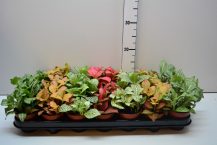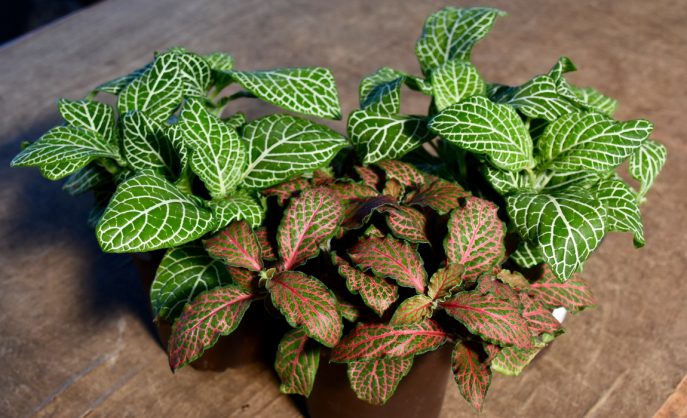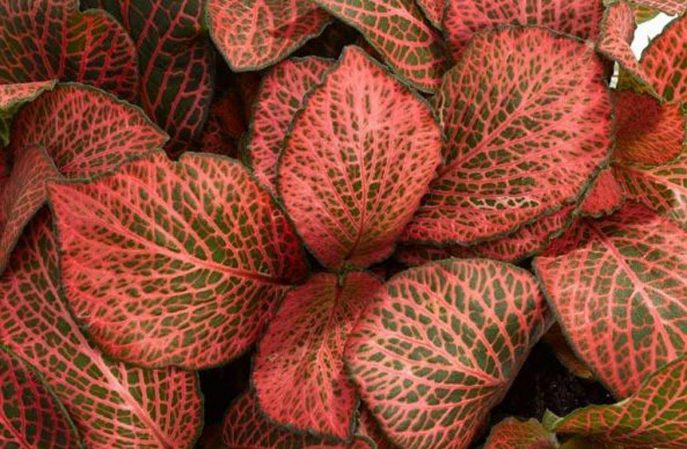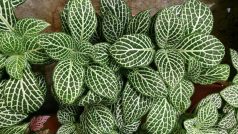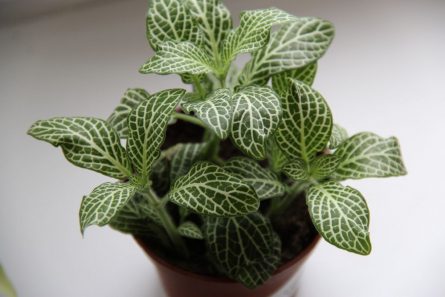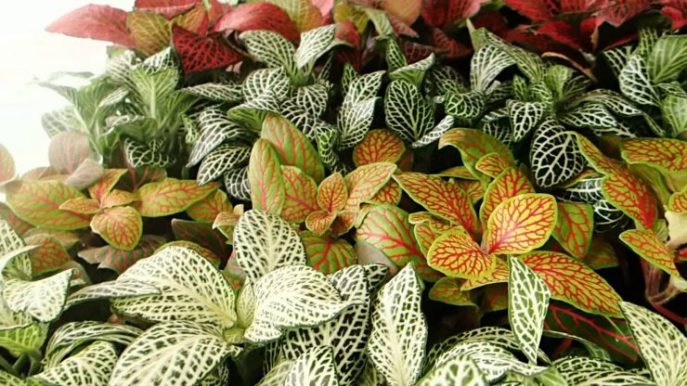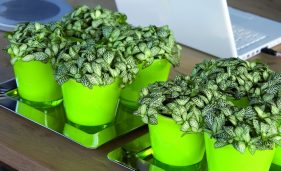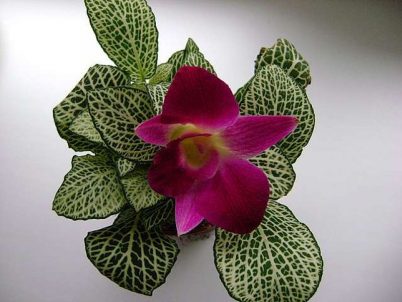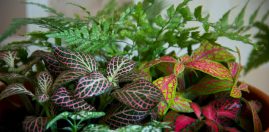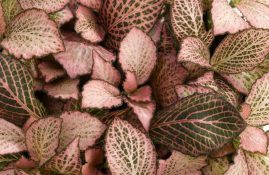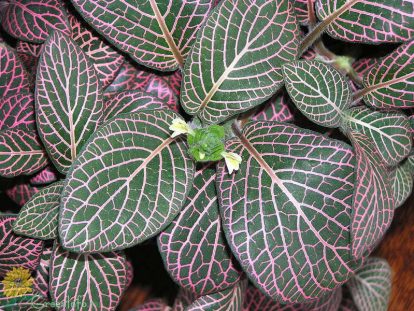In many houses, on window sills, you can find decorative indoor plants. Among them, the Fittonia mix flower is often found. Care and requirements for this type of indoor plants does not require special skills and labor.
Material Content:
Plant description
The plant belongs to the family of acanthus, the native land of its growth is South America. In nature, there are about 10 of its varieties. A perennial herbaceous plant may differ in appearance, in the shape of leaves and stems. Leaves can take on different colors. Starting from light green, green, pink, to bright red. The decoration of the indoor flower is the presence of silver streaks on the foliage.
The stems can be erect and creeping. An adult plant can reach a height of up to 50 cm with a branched and lush crown. During flowering, the plant produces an inflorescence in the form of an ear with small yellow flowers reaching a length of up to 5 cm. Flowering begins in the spring-summer period, from May, and lasts for 2 weeks until the inflorescences completely dry.
Fittonia mix: basic requirements for growing
Fittonia is an unpretentious plant, but still has certain requirements for care. They consist of the following steps:
- Perform moderate watering and irrigation daily.
- Provide the flower with optimal temperature and humidity.
- Choose a pot with a plant suitable place.
- Ventilate the flower and supply fresh air.
- Transplant at least 1 time in 3 years, as the pot is filled with the root system.
- Fertilize with special fertilizers in a timely manner.
- When diseases and pests occur, take preventive measures to combat them.
Important! With proper and timely care of Fittonia, for a long time it will delight the owner with its abundant foliage and inflorescences.
Home Care
Plant care consists of several stages:
- lighting;
- temperature;
- watering;
- humidity;
- fertilizers;
- soil composition.
In order to avoid problems when caring for a tropical flower, it is important to follow certain standards.
Soil and fertilizer for a flower
The soil for Fitoni should be nutritious and loose so that oxygen can flow to its roots. The soil mixture can be bought ready-made, which is intended for a suitable kind of plants. And also do it yourself by mixing components from equal parts:
- deciduous land;
- peat;
- sand;
- coniferous soil;
- black soil.
Be sure to provide drainage at the bottom of the pot. For him, you can apply expanded clay or small pebbles.
Top dressing should be done with mineral fertilizers, with a dosage reduced by half. Start fertilizing with the onset of spring, before the end of autumn, at least 2 times a week. In winter, the plant does not need fertilizing.
Watering Fittonia mix
Indoor flower requires abundant watering in the spring and summer. Watering it is necessary daily, as the soil dries. It is better to use purified or settled water. With the onset of autumn, it is necessary to provide the flower with moderate watering, 2-3 times a week. In winter, water no more than 1 time per week.
Each week, irrigate the flower with clean room temperature water from a spray bottle. And also carry out wet cleaning of leaves with a soft cloth from dust and dirt.
Important! It is better if the soil in the pot with the plant is slightly dry than waterlogged. Excessive watering can adversely affect the root system, rot begins.
Lighting, humidity and optimum temperature
Indoor flower Fittonia prefers high humidity indoors. To provide her with suitable wet conditions, you can organize a pool near the flower. Pour water into the cup so that it evaporates, and also place the pot on the aquarium. It is allowed to place the pot in a cup of water by placing a drain in it so that the roots of the plant do not touch the water.
Indoor flower is a photophilous plant, it needs bright sunlight. At the same time, it is impossible for direct rays to fall on the plant. To avoid leaf burns, it is best for it to provide shading from paper. In the winter season of Fittonia, it is important to provide additional lighting from artificial lamps. With a lack of light, the stems can stretch out. It should not be allowed to place pots near the heating pipes, this will negatively affect the appearance of the flower.
The temperature should not exceed 25 degrees in the summer. In winter, the temperature should not drop 18 degrees. Sudden jumps and temperature changes can cause the flower to die. The optimum is 23 degrees. With a slight increase, the plant needs to increase humidity.
It is not recommended to take out the pot for ventilation in fresh air, and also try to avoid drafts. If ventilation occurs in the room, the pot with the plant should be taken to another place.
Winter care
In winter, the plant should pay more attention. Care for it is necessary daily, to be fully implemented. It consists of the following points:
- Maintaining optimal humidity at about 80 percent throughout the year.
- The optimum temperature for the flower in winter should be at least 18 degrees.
- In cold weather Fittonia it is necessary to increase daylight hours, with the help of additional lighting. Due to a lack of light, it fades. A great place to serve is the windowsill, located on the east side.
- Watering should be done at least 2-3 times a week.
- In winter, an indoor flower does not need top dressing. They stop in the last month of autumn.
In order to prevent the death of decorative home decoration, it is important to properly and timely provide care, especially during the winter dormancy.
Features of breeding Fittonia
Breeding Fittonia is best to start in the spring or in the middle of summer. It is performed in several ways:
- layering;
- division of the main bush;
- cuttings.
By dividing the bush propagated in the spring. To do this, separate the roots into several parts, removing rotten rhizomes and lumps of earth. To pick up pots with a diameter of 2 cm more for the "dividend".
To cuttings in spring or summer, prepare a stalk 5-7 cm long so that it contains at least 2-3 leaflets. They are pre-soaked in a root solution and placed in containers with sand, deepened by 1 cm. For rapid growth, containers with seedlings are covered with polyethylene on top, creating the effect of a greenhouse. Open bags daily for 5 minutes airing. After the new sprouts appear, the film must be removed.
Propagation by layering is an easy way. From the mother bush, take the lowest layer, remove leaves from it and bend to the soil, sprinkle with a small amount. After the layer is rooted, it is separated with a sharp object and transplanted into a separate pot.
Transplant at home
The transplantation of Fittonia of an adult bush is carried out in the spring period not more often than after 2-3 years, as the pot is filled with rhizomes. Young plants can be replanted every year. Important conditions during transplantation are fertile and loose soil, as well as a drainage layer.
It is necessary to choose the right container. It is better to pick up a pot larger in size, by 2 cm. Due to the branching root system, a wide and shallow capacity is the best option.
Important! Do not pick up pots with large diameters, the plant can slow growth.
Pest and Disease Control
Like many houseplants, Fittonia can be affected by diseases and pests. Although more rare, pests may appear on it. The most common and famous are:
- scale shield;
- spider mite.
The appearance of the scale can be seen with the naked eye. Brown plaques appear on the leaves. After their appearance, the plant begins to dry out, can lead to death. To combat, you can use a soap solution, carefully treating all parts of the plant. In severe cases, fungicides are used for irrigation.
The appearance of the spider mite often occurs with low humidity, dry air. A spider web forms on the inside of the leaf. To combat this pest, it is necessary to treat the bushes with insecticides.
Diseases may appear on the flower due to improper care. They differ in certain ways:
- The leaves are curled. More often occurs with a lack of moisture and bright lighting.
- Yellowing bush. Appears with severe overmoistening of the soil.
- If the leaves fall, the stalk becomes bare, the plant requires pruning to form a new crown.
- Sluggish stems are formed if the temperature drops below the optimum.
- Fading and dull leaves appear in high and bright room lighting.
- Foliage falls with an excess of moisture, and dry air.
To prevent the emergence of diseases and pests, the plant requires proper and competent care. In response, it will thank its owner with plentiful multi-colored foliage. It will also become a decoration at home.



